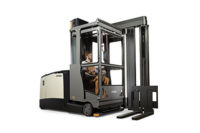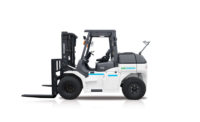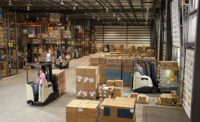Increased use of technology is changing the way businesses operate. At Crown Equipment, New Bremen, Ohio, we are always monitoring new technologies and  evaluating how their adoption impacts refrigerated warehouses and distribution centers. More specifically, we’re thinking about the evolving work experience for warehouse managers and forklift operators created by the opportunities of new technologies. And, as a forklift provider to the refrigerated warehouse segment, Crown knows that forklifts and associated technologies operating in cold storage environments must be designed and built for increased durability to perform in harsh conditions.
evaluating how their adoption impacts refrigerated warehouses and distribution centers. More specifically, we’re thinking about the evolving work experience for warehouse managers and forklift operators created by the opportunities of new technologies. And, as a forklift provider to the refrigerated warehouse segment, Crown knows that forklifts and associated technologies operating in cold storage environments must be designed and built for increased durability to perform in harsh conditions.
Regardless of environment, the forklift—and warehouse as a whole—is becoming more connected. The everyday experience of operators and warehouse managers will be drastically impacted as they learn how data can be captured by forklifts, how to effectively use data to support decision making and how to be informed by and engaged with their equipment.
Gathering data
The adoption of technology in the warehouse, particularly programs related to fleet and operator management, yields an abundance of data. Through operator log-ins, important productivity metrics—including average travel time, average lift time, actual travel times, actual lift times, time stopped and time stopped with no operator—can measure and benchmark individuals and groups. Additional information tracked through fleet and operator management systems, including number of impacts and truck maintenance reports, make it possible for warehouse managers to make informed decisions based on real-time statistics across all facilities, departments and shifts.
The forklift is just one element of the connected warehouse, but because of its role and close proximity to warehouse activity, it will emerge as a primary data collector for the warehouse. The forklift—and its operator—is at the front lines of warehouse activity, allowing the technology-equipped machine to aggregate much of the information, such as impacts, maintenance reports and battery charging levels, that has traditionally been gathered from different sources. The forklift’s ability to serve as a technology hub—gathering information at each warehouse touch point and interaction—elevates the role of this already critical warehouse element. And, because operators are part of this front-line activity, they will develop a deeper understanding of how their actions impact warehouse productivity, efficiency and safety.
Streamlined data collection can also help improve service management and automate processes, such as collecting compliance records, to improve operational efficiency, consistency and safety. By developing a detailed understanding of what information can be gathered by the forklift and implementing that collection, warehouse managers can begin to use the data to shape their decision-making.
For example, meat processing company Clemens Food Group, Hatfield, Pa., implemented Crown’s InfoLink fleet and operator management system. Before the installation began, the team identified areas in their operation they initially wanted to target with the system to uncover efficiency or cost-cutting opportunities, such as focus areas of OSHA compliance, operator certification and impact detection. Only five months after the completion of the installation project, Clemens realized significant improvements in all three of these areas. Because the system allows the company to assign a PIN number to each operator, managers were able to limit access to the vehicle to only those operators with the required certification needed to operate the forklift. Also, by integrating the inspection checklist into the system, Clemens was able to automate the process and ensure the operator performs the inspection with the proper attention to detail.
Turning data into decisions
With access to all this warehouse-level data comes a series of inherent challenges to analyze information quickly, minimize and filter out the “noise” and integrate data from across various sources and systems to provide a unified view of warehouse operations. By having a clear understanding of warehouse data—including what, how, when and why it is captured—warehouse managers can more quickly minimize irrelevant information and better understand how to make decisions based on real-time information.
Too much data can be as much of a problem as not having enough data. The technology used by warehouse managers must be intuitive and easy to understand at-a-glance, rather than requiring busy managers to scroll across multiple pages for comparisons. Data must be presented in a way that provides timely results and enough context to make decisions, and managers need to be able to quickly use the gathered data to identify trends and draw conclusions. For example, low productivity may be correlated with higher impact reports or maintenance records. By interpreting the data, managers can isolate the root causes of issues.
Forklift operators play a role in using data, as well. Given their experience with the equipment and visibility into warehouse activities, operators can provide additional context for reports, confirm trends, remedy issues and improve productivity based on data gathered by the forklift.
Engaging operators
As the forklift becomes more integrated with warehouse technology, the operator experience will also evolve. The data gathered by forklifts provides greater insight into the operator’s daily activities and efforts, providing real-time information about safety, performance and productivity that simply has been a guess in the past. These metrics can be used for discussions between operators and managers about responsibility and performance, providing clear opportunities for improvement, as well as real data to demonstrate a job done well.
Clemens uses InfoLink to monitor and evaluate the productivity of its operators and the utilization of the fleet. As a result, warehouse managers gather performance information, monitoring benchmarks, identifying the most productive operators and working with operators that need additional training.
It’s also important to recognize that the warehouse workforce is evolving as millennials enter the market. Millennials are inherently tech-savvy workers who expect their machines to be interactive and engaging to a degree that the current generation may not be accustomed. This is a generation who has grown up with smartphones, video games and touch-screen automobiles, from which they gain quick access to virtually any information at any time.
As a result, feedback on safety and operational performance is an inherent expectation for these workers. They want access to their performance metrics through real-time information shared by management during operator reviews and discussions. Understanding this data allows operators to assert ownership for their successes and helps managers and operators to focus discussions on tangible opportunities and accomplishments recorded by the forklift.
The adoption of technology in the warehouse won’t be without challenges. But, understanding how to filter data gathered by the forklift, as well as how to use that data to create a more meaningful forklift operator experience, are steps in the right direction.



